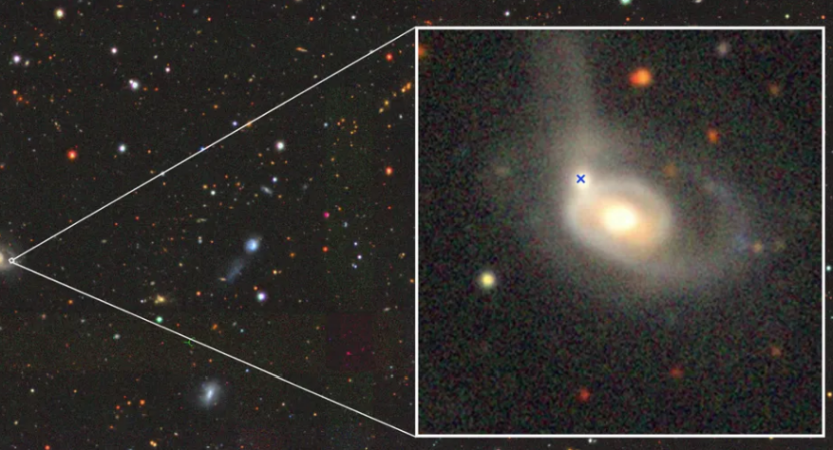Astronomers have conducted an in-depth investigation of a rare and extremely violent cosmic phenomenon triggered when an ill-fated star wandered too close to a supermassive black hole. The research team anticipates that this analysis may provide further insight into how such events—called "tidal disruption events," or "TDEs"—affect the development of the galaxies that host them.
These fierce confrontations between stars and the colossal gravitational pull of black holes, which possess masses millions or even billions of times greater than that of the Sun, result in stars being torn apart and consumed by the black holes. This form of cosmic consumption emits brilliant flashes of light, often brighter than the collective luminosity of every star in the galaxy where the TDE occurs, signaling to scientists the occurrence of a violent stellar demise.
The specific TDE in focus has been identified as AT 2022wtn and took place in a galaxy roughly 700 million light-years from Earth. This galaxy is in the early phases of merging with a neighboring galaxy.
The galaxy hosting the TDE is named SDSSJ232323.79+104107.7 and is the smaller of the two galaxies involved in the collision. The second galaxy in this interaction is estimated to be at least ten times larger than SDSSJ232323.79+104107.7.
You may like:
Hubble Telescope sees wandering black hole slurping up stellar spaghetti
Doomed star circling supermassive black hole could be ripped apart in less than 6 years
NASA spacecraft spots monster black hole bursting with X-rays 'releasing a hundred times more energy than we have seen elsewhere'
It is believed that these two galaxies have already undergone a close approach to one another.
A background of black, dotted with white, red, and blue orbs, includes an inset image featuring a yellow swirl marked by a blue cross in the northwest section. This image, from the Legacy Survey DR10, shows the AT 2022wtn field. The inset highlights the transient event located at the nucleus of the interacting smaller galaxy, pinpointed by the blue cross. The image clearly displays the tidal tails created by the gravitational forces and merging activity of the two galaxies. (Image credit: Legacy Surveys / D. Lang (Perimeter Institute) / INAF / F. Onori)
This case marks only the second instance in which a TDE has been identified in merging galaxies. This is notable given the prevailing theory suggesting that early galactic merger stages are likely to foster the conditions that lead to these extreme phenomena.
How a star became stellar spaghetti
AT 2022wtn was initially detected by astronomers at the Zwicky Transient Facility (ZTF), followed by more detailed analysis across various wavelengths of light—from radio waves to infrared and even X-rays—which confirmed its identity as a TDE. Through this investigation, scientists determined that the black hole responsible for the event has a mass approximately equal to one million times that of the Sun, while the star being consumed was a low-mass star.
Yet, although this event is clearly a typical example of a supermassive black hole tearing apart a star, it displays some unique features that differentiate it from previously studied TDEs.
“It is a peculiar event. Its light curve is characterized by a plateau in the phase of maximum brightness, lasting about 30 days, accompanied by a sharp drop in temperature and a spectral sequence that shows the development of two emission lines corresponding to the wavelengths of helium and nitrogen,” stated Francesca Onori, team leader from the National Institute for Astrophysics (INAF). “Something that we had never observed with such clarity.”
A closer look at the tidal disruption event AT 2022wtn, composed of a black hole tearing apart and consuming a star.
(Image credit: Legacy Surveys / D. Lang (Perimeter Institute) / INAF / F. Onori)
Like all TDEs, AT 2022wtn began when the doomed star’s orbital path brought it dangerously close to the central supermassive black hole at the core of its galaxy. The black hole’s immense gravitational pull exerted intense tidal forces on the star, compressing it horizontally while stretching it vertically in a process vividly described as “spaghettification.”
Fragments of the star's matter then spiraled around the voracious black hole, forming a swirling, disk-shaped cloud of plasma known as an accretion disk.
Illustration of a tidal disruption event showing a star being consumed by a black hole, forming an accretion disk.
(Image credit: ESA/C. Carreau)
However, not all of the stellar debris is pulled into the black hole’s grip. A large portion is expelled in the form of fast-moving, powerful outflows or jets. In the case of AT 2022wtn, these outflows generated a brief but bright radio signal from the TDE and caused significant changes in the velocities of the elements emitting light in the vicinity.
This revealed that the star had been completely obliterated, and in addition to the formation of an accretion disk, the violent event produced an expanding spherical cloud—or "bubble"—of ejected gas.
Related Stories:
— Black hole announces itself to astronomers by violently ripping apart a star
— Massive star's gory 'death by black hole' is the biggest and brightest event of its kind
— Star escapes ravenous supermassive black hole, leaving behind its stellar partner
“We found clear traces of the dynamics of the surrounding material also in some emission lines which show characteristics compatible with a fast propagation towards the outside,” Onori added. “Thanks to our monitoring campaign, we were able to propose an interpretation of the origin of the observed radiation: AT2022wtn gave rise to a rapid formation of the disk around the black hole and the subsequent expulsion of part of the stellar matter.
“This result is particularly relevant, since the source of visible light and the physical conditions of the region from which it comes, in TDEs, are still under study.”
The findings of the team’s research were published on May 23 in the Monthly Notices of the Royal Astronomical Society.

